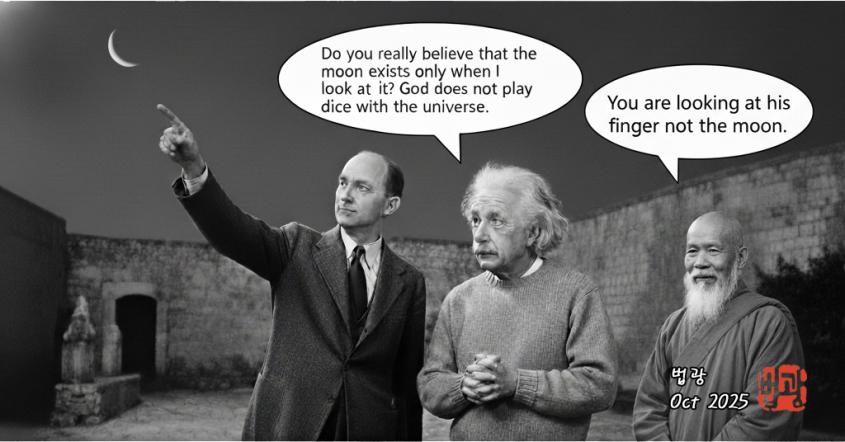Einstein's Question about the moon / 달에 대한 아인슈타인의 질문

Background of Zen Q&A:
The "debate" between Einstein and Bohr over the moon was a thought experiment about quantum mechanics, not a literal debate about a physical moon. Einstein famously asked Bohr, "Do you really believe that the moon exists only when I look at it?". This questioned the Copenhagen interpretation of quantum mechanics, which Bohr championed, suggesting that a particle's properties are not definite until measured. Einstein, a believer in a rational, objective reality, thought a particle should have properties independent of observation.
When Einstein posed the question, Bohr reportedly replied that Einstein could not prove the moon exists when unobserved, and therefore it was a question that could not be resolved by proof—a fundamental difference in how they viewed reality and knowledge.
While their disagreement was philosophical and not fully settled in their lifetimes, experimental evidence decades later has strongly supported the Bohr side of the debate.
Experiments testing Bell's inequality with entangled particles have confirmed quantum entanglement and non-locality, which supports the idea that particles can influence each other instantaneously over distance, regardless of what Einstein thought of it.
[Notes] In Buddhism, the "finger pointing to the moon" is a metaphor for the means (sutras, teachings, etc.) toward truth or enlightenment. It emphasizes that we should not be fixated on the means but instead focus on the essence, the moon (truth, enlightenment), leading to the saying, "Once you've seen the moon, forget the finger."
● Finger: Refers to the means of conveying essence, such as sutras, texts, teachings, and methods of practice.
● Moon: Represents truth, enlightenment, the mind of the Buddha, and the ultimate goal.
● Meaning: Just as we point to the moon with our finger, but remain focused on the finger, we should not lose sight of the moon. Similarly, this teaching emphasizes that we should not lose sight of truth by becoming immersed in teachings or sutras.
★ Source from: Google AI
달에 대한 아인슈타인의 질문
달을 가르키고 있는 보어에게 아인슈타인이 말하였다.
"달이 내가 볼 때만 존재한다고 정말로 믿는가? 신은 우주를 가지고 주사위 놀이를 하지 않는다네."
옆에서 대화를 듣고 있던 선지식(善知識)이 말했다.
"당신은 달을 보는 것이 아니라 그의 손가락을 보고 있군요."
선문답(禪問答)의 배경:
아인슈타인과 보어가 달을 두고 벌인 "논쟁"은 물리적 달에 대한 문자 그대로의 논쟁이 아니라 양자역학에 대한 사고 실험이었습니다. 아인슈타인은 보어에게 "달이 내가 볼 때만 존재한다고 정말로 믿습니까?"라고 물었습니다. 이는 보어가 옹호했던 양자역학에 대한 코펜하겐 해석에 의문을 제기했습니다. 코펜하겐 해석은 입자의 속성이 측정되기 전까지는 확정되지 않는다고 주장했습니다. 합리적이고 객관적인 실체를 믿었던 아인슈타인은 입자가 관찰과 무관한 속성을 가져야 한다고 생각했습니다.
아인슈타인이 이 질문을 던졌을 때, 보어는 관찰되지 않은 달의 존재를 증명할 수 없기 때문에 증명으로 해결할 수 없는 문제라고 답했다고 합니다. 이는 두 사람이 현실과 지식을 바라보는 방식의 근본적인 차이였습니다.
두 사람의 의견 차이는 철학적 차이였고 생전에 완전히 해결되지는 않았지만, 수십 년 후 실험적 증거는 보어의 주장을 강력하게 뒷받침했습니다.
얽힌 입자를 대상으로 벨의 부등식을 검증하는 실험은 양자 얽힘과 비국소성을 확인했는데, 이는 아인슈타인의 생각과는 관계없이 입자들이 거리에 관계없이 순간적으로 서로 영향을 미칠 수 있다는 생각을 뒷받침합니다.
[참고사항] 불교에서 '달을 가리키는 손가락'은 진리나 깨달음을 향한 수단(경전, 가르침 등)을 비유하는 표현입니다. 이는 수단에 집착하지 말고 본질인 달(진리, 깨달음)을 보아야 함을 강조하며, "달을 봤으면 손가락을 잊어라"는 말로 이어집니다.
● 손가락: 경전, 문자, 가르침, 수행 방법 등 본질을 전달하기 위한 수단을 의미합니다.
● 달: 진리, 깨달음, 부처의 마음, 궁극적인 목표를 의미합니다.
● 의미: 손가락으로 달을 가리키지만, 손가락에만 머물러 달을 놓치지 말아야 하듯, 가르침이나 경전에 매몰되어 진리를 놓쳐서는 안 된다는 가르침입니다.
자료출처: Google AI
| No. | 제목 | 구분 | 작성일 | 조회 |
|---|---|---|---|---|
21 | Questions about resurrection / 부활에 대한 질문 | Zen Q&A/선문답 | 2035-12-31 | 457 |
20 | A lotus born from fire / 불속에서 피어난 연꽃 | Zen Poem/선시 | 2035-12-30 | 139 |
19 | Not two, but ONE / 둘이 아닌 하나 | Zen Poem/선시 | 2035-12-29 | 235 |
18 | What is the true color of a maple leaf? / 단풍잎의 ... | Zen Q&A/선문답 | 2025-11-07 | 17 |
17 | To Return to light / 회광반조(回光返照) | Zen Poem/선시 | 2025-11-03 | 51 |
16 | Why must we awaken? / 우리는 왜 깨어나야 하는가? | Zen Poem/선시 | 2025-10-23 | 82 |
15 | Where is the True Self? / 참나는 어디에 있습니까? | Zen Q&A/선문답 | 2025-10-22 | 84 |
14 | What is moving? / 무엇이 움직이는가? | Zen Q&A/선문답 | 2025-10-21 | 105 |
13 | Is this world my dream? / 이 세상이 나의 꿈이라고? | Zen Q&A/선문답 | 2025-10-20 | 89 |
12 | Einstein's Question about the moon / 달에 대한 아인슈타... | Zen Q&A/선문답 | 2025-10-20 | 82 |